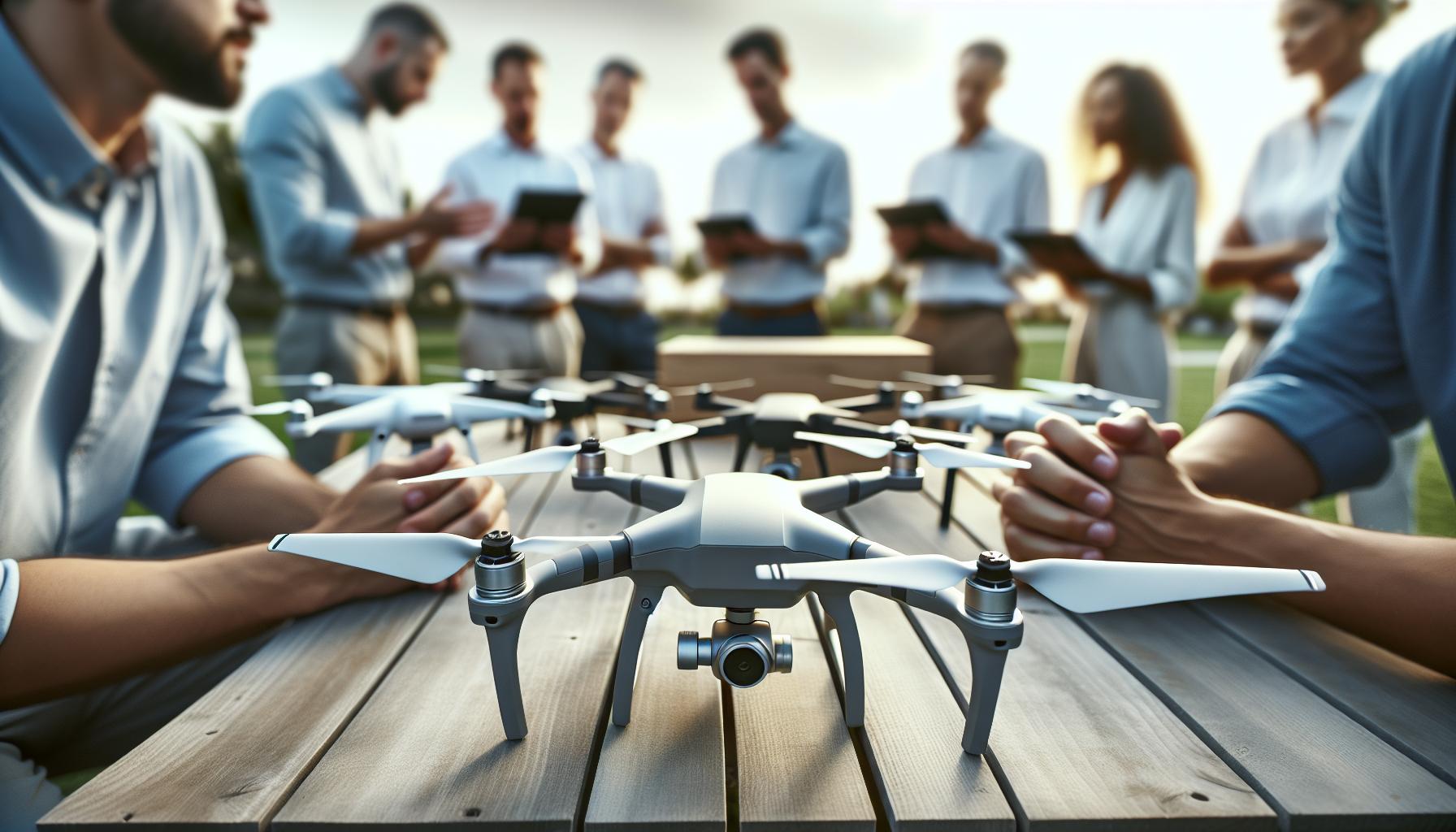With DJI’s groundbreaking innovations, the company has transformed the drone industry, empowering millions to explore aerial photography and videography. But just how many drones has DJI sold since its inception? Understanding DJI’s total sales not only reflects the brand’s dominance in the consumer and professional drone markets but also highlights the growing popularity of drone technology. As aspiring pilots and seasoned operators alike consider their next purchase, knowing the scale of DJI’s impact can inform their decisions. Join us as we delve into the numbers and uncover what these sales figures mean for both the industry and you as a drone enthusiast.
How Many Drones Has DJI Sold?

DJI has achieved astounding sales figures since its inception in 2006, significantly dominating the global drone market. By 2021, industry estimates suggested that DJI had sold over 1 million drones annually, with cumulative sales surpassing 10 million units since its founding. This staggering number underscores DJI’s influence and leadership in the consumer drone space, with models like the Phantom and Mavic series leading the charge.
The company’s successful sales trajectory can be attributed to a combination of innovative technology and reliable performance, which resonates strongly with both amateur and professional users. Key models such as the Mavic Mini, celebrated for its portability, and the Phantom series, known for their high-quality aerial imaging capabilities, have become staples among drone enthusiasts. The expansive range offered by DJI caters to various demographics, from casual hobbyists looking for easy-to-operate drones to seasoned professionals in need of advanced features.
Beyond sheer numbers, DJI’s sales have impacted the drone industry as a whole, pushing competitors to enhance their offerings and contribute to the rapid evolution of drone technology. This competitiveness has led to improved features such as enhanced flight times, greater stability, and advanced obstacle avoidance systems, all of which can be seen as a direct response to DJI’s market leadership. The continual growth in sales reflects an increasing acceptance and integration of drone technology across multiple sectors, including photography, agriculture, and logistics, indicating a promising future for both DJI and the drone industry at large.
Historical Sales Milestones for DJI Drones
Since its inception in 2006, DJI has marked numerous impressive milestones in drone sales, highlighting its dominance in the global market. By 2021, the company reached a significant benchmark, selling over 1 million drones annually. This sales surge allowed cumulative sales to exceed 10 million units-a staggering achievement that has defined DJI as the leading force in the consumer drone sector.
The journey to these milestones began with the introduction of groundbreaking models. The DJI Phantom series, launched in 2013, set the stage for aerial photography with its user-friendly interface and high-quality imaging capabilities. Following that, the Mavic series ushered in a revolution in portability and advanced features, with the Mavic Pro debuting in 2016, quickly becoming a favorite among both amateurs and professionals due to its foldable design and impressive performance. Over the years, other models like the Mavic Mini and the Avata introduced DJI to new demographics, including casual users seeking reliable yet compact options.
DJI’s success in sales can also be attributed to its innovative technological advancements. Features such as 4K video capability, enhanced flight stability, and automated shooting modes have captivated consumers and kept competitors on their toes. Furthermore, each new release tends to sell out rapidly, showcasing not just demand but also the brand’s strong hold on consumer trust.
Ultimately, the milestones achieved by DJI are not merely numbers; they symbolize a transformative journey in aerial technology and consumer engagement, threading together a narrative of innovation that continues to evolve. As the industry grows and new technologies emerge, DJI’s commitment to maintaining its leadership position suggests that even more significant milestones are yet to come.
Exploring DJI’s Best-Selling Drone Models

Among the myriad of drones available today, a few models have emerged as best-sellers, reflecting both consumer preference and technological advancement. At the forefront is the DJI Phantom series, which, since its introduction in 2013, has become synonymous with high-quality aerial photography. These drones are celebrated for their stability, image quality, and ease of use, making them ideal for both amateurs and seasoned photographers alike. The Phantom 4, for instance, became a game-changer with its advanced obstacle avoidance features and intelligent flight modes, driving substantial sales and setting industry standards.
Following closely is the Mavic series, particularly the Mavic Pro, which debuted in 2016. This model revolutionized portability in the drone market with its foldable design, allowing users to easily transport it without sacrificing performance. Its capability to shoot 4K video and deliver a flight time of approximately 27 minutes further cemented its popularity. Subsequent releases, such as the Mavic Air and Mavic Mini, catered to even broader demographics, with the latter appealing particularly to newcomers with its user-friendly interface and lower price point.
Another noteworthy contender is the DJI Mini series, which has dramatically broadened the appeal of drones. The Mavic Mini and Mini 2 are lightweight, compact, and compliant with regulations that make them accessible to casual users. These drones deliver impressive 2.7K video quality, profiling a market shift towards user-friendly devices that still perform exceptionally well. The affordability and ease of use of the Mini series have led to significant sales numbers, particularly appealing to hobbyists and those new to drone flying.
The launch of the Avata, a FPV (first-person view) drone, further diversifies DJI’s offerings, introducing users to an immersive flying experience. This model combines agility and ease of use, allowing pilots to experience flight in an entirely new way. The increasing interest in FPV and cinematography has seen Avata gain traction among enthusiasts, enhancing DJI’s presence in this niche market.
Overall, the diversity within DJI’s best-selling models illustrates the company’s ability to cater to a broad spectrum of users-from casual flyers to professional photographers. This strategic product development not only drives sales but also reinforces DJI’s dominant position within the drone industry, making it a go-to choice for anyone considering entering this exciting realm of technology.
The Impact of Drone Sales on the Industry

The rapid ascent of DJI in the drone market has not only revolutionized aerial photography and videography but has also significantly impacted the broader drone industry. As DJI continues to dominate with impressive sales figures, the ripple effects can be seen across various sectors, from recreational use to professional applications, shaping consumer expectations and technological advancements in the industry.
By setting high standards for performance, user-friendliness, and innovative features, DJI has pushed competitors to elevate their offerings. Manufacturers are compelled to develop drones that incorporate features like advanced obstacle avoidance, enhanced flight stability, and superior imaging capabilities to remain relevant. This has effectively raised the bar, compelling the industry to foster innovation through increased research and development, ultimately benefiting consumers with better products.
Moreover, the affordability and accessibility of DJI’s products, particularly in the Mini and Mavic series, have democratized drone flying, attracting not only hobbyists but also educators, filmmakers, and businesses. This influx of new users has catalyzed the establishment of supportive infrastructure, including community forums, flight schools, and workshops aimed at educating enthusiasts and professionals alike. As more individuals and companies adopt drone technology, industries such as real estate, agriculture, and cinematography are embracing drones for enhanced efficiency and creativity in operations.
Furthermore, regulatory bodies have taken note of the widespread adoption of drones, leading to the development of clearer guidelines and regulations governing their use. This regulatory landscape is crucial for future growth, ensuring that drone operations are safe, responsible, and beneficial to society. As DJI continues to lead in sales, its influence on these regulations also underscores the importance of responsible drone use, encouraging manufacturers and users alike to prioritize safety and compliance.
In conclusion, DJI’s outstanding sales metrics reflect not just its success but its influential role in shaping the drone industry’s landscape. By driving competition and enhancing user engagement, DJI is paving the way for a future where drone technology becomes an integrated part of daily life across various sectors, ultimately fostering an environment of continuous innovation and growth.
Annual Sales Trends and Forecasts for DJI
The drone market has witnessed staggering growth over the past decade, and DJI stands at the forefront of this evolution with remarkable annual sales trends that reflect its dominance. As of recent estimates, DJI’s total number of drones sold has surpassed the 30 million mark globally, establishing it as the world’s leading drone manufacturer. A notable aspect of this growth is the increase in consumer demand for both recreational and professional drones, which has accelerated sales. With each passing year, DJI has introduced innovative models that cater to diverse user needs, from casual hobbyists to serious filmmakers and enterprise users.
Analyzing DJI’s annual sales trends reveals that the introduction of new technologies and features significantly impacts their sales performance. For instance, the launch of the Mavic Air 2 and the Mavic Mini saw an immediate spike in sales due to their affordability, portability, and cutting-edge capabilities like 4K video and intelligent flight modes. Moreover, seasonal trends indicate that DJI often experiences heightened sales during holidays and major promotional events, with sales peaks around Black Friday and the summer months, when outdoor activities surge.
Forecasting future sales, industry analysts suggest that DJI’s growth trajectory will continue in the coming years, albeit at a more moderated pace as the market matures. This prediction is underpinned by the increasing adoption of drones in various sectors, including agriculture, real estate, and cinematography. The integration of aerial imaging technology into these industries not only supports DJI’s growth but also enhances the overall functionality of drones, paving the way for innovative applications that were previously unimaginable.
Ultimately, as DJI continues to refine its product offerings and expand its reach into emerging markets, the company’s sales trends will likely reflect ongoing consumer interest in drone technology and its applications. By maintaining a focus on innovation and user engagement, DJI is well-positioned to sustain its leadership in the drone industry, continuously adapting to market demands and consumer preferences.
Understanding Market Share: DJI vs. Competitors

DJI’s impressive market share in the drone industry is not merely a point of pride but a testament to its strategic excellence and innovation-driven approach. As of recent estimates, DJI commands over 70% of the global commercial drone market, a figure that starkly contrasts with its closest competitors, such as Parrot and Skydio, which have only a small fraction of the market. This dominance is particularly evident in the consumer segment, where DJI’s user-friendly designs and cutting-edge technology have set a high bar for quality and performance.
One of the major factors contributing to DJI’s market supremacy is its extensive range of products designed for various user needs. From the compact DJI Mini series aimed at casual users to the robust Inspire models favored by professional filmmakers, DJI has created an ecosystem that appeals broadly. Furthermore, its consistent innovation-like the introduction of AI-assisted flight features-ensures that DJI remains relevant and attractive to both new buyers and seasoned operators. Each new model release tends to generate significant buzz and often results in increased sales, exemplifying the brand’s ability to captivate its audience.
Furthermore, DJI’s strategic partnerships and distribution channels amplify its reach, allowing it to penetrate various markets more effectively than many competitors. By collaborating with retailers globally and instituting an efficient online sales model, DJI has made purchasing drones accessible and straightforward for consumers. In contrast, competitors often struggle with visibility and accessibility, making it challenging to capture a comparable share of the market.
As the drone industry continues to evolve with increased applications in industries like agriculture, real estate, and filmmaking, DJI’s market position is likely to solidify further. This growth is fueled by the broader adoption of drone technology across these sectors, where DJI’s innovative solutions are frequently preferred due to reliability and superior performance. For potential buyers or enthusiasts, understanding this landscape not only highlights DJI’s strengths but also informs decisions when exploring their options in an increasingly competitive market.
Reasons Behind DJI’s Sales Success
The extraordinary success of DJI can be largely attributed to a combination of innovative technology, diverse product offerings, strategic marketing, and robust support mechanisms. By understanding these elements, enthusiasts and prospective buyers can appreciate not just the popularity of DJI drones but also the underlying strategies that have driven their impressive sales figures.
One primary factor in DJI’s success is its commitment to innovation. The company consistently integrates the latest technology into its products, such as high-definition cameras, advanced obstacle avoidance systems, and AI-powered flight features. For instance, models like the DJI Air 3 and the Mavic series have made aerial photography accessible to both amateurs and professionals, thanks to user-friendly interfaces and high-quality imaging capabilities. This relentless pursuit of technological advancement not only captivates existing customers but also attracts new users seeking reliable and sophisticated drone solutions.
Additionally, DJI’s diverse product lineup allows them to cater to a broad spectrum of customers. From the compact, budget-friendly Mini series for newcomers to the high-end Inspire models preferred by seasoned filmmakers, DJI has successfully created an ecosystem that meets various needs. This strategic segmentation ensures that there’s a suitable option for every potential user, which effectively enhances market penetration. The company also leverages customer feedback to refine and improve its existing products, ensuring continued relevance and customer loyalty in an ever-evolving market.
Equally important is DJI’s effective marketing strategies. The company has mastered the art of creating anticipation through well-timed product launches, engaging promotional campaigns, and collaborations with key influencers in the drone space. By showcasing impressive footage captured by their products and highlighting user testimonials, DJI builds credibility and attracts attention. This powerful marketing approach not only educates potential buyers about the capabilities of their drones but also helps to foster a vibrant community of enthusiasts who actively share their experiences and expertise.
Lastly, DJI’s commitment to customer support and community engagement plays a crucial role in its sales success. The company provides extensive resources, including tutorials, forums, and customer service, which ease the learning curve associated with new technology. This comprehensive support system fosters trust and encourages new users to embark on their drone flying journeys, knowing that assistance is readily available.
Through a blend of cutting-edge innovation, a wide range of accessible products, savvy marketing, and solid customer support, DJI has established a formidable presence in the drone market, making it the go-to choice for both casual users and professionals alike.
Customer Demographics: Who Buys DJI Drones?
DJI’s dominance in the drone market can be seen not just in their impressive sales figures, but also in the diverse demographic of users who choose their products. A wide range of buyers-ranging from hobbyists to professionals-each finds value in what DJI offers. Popular among drone enthusiasts, amateur filmmakers, and even large organizations in sectors like agriculture, surveying, and emergency services, DJI’s user base is expansive and varied.
One of the key demographics includes hobbyists and enthusiasts who seek high-quality aerial photography and video capabilities. The user-friendly interfaces of models such as the DJI Mini series and Mavic Air appeal to those new to drone flying, while advanced features attract seasoned pilots. These products provide a perfect gateway for influencers and recreational users eager to share stunning visuals on social media platforms, where aerial content is particularly captivating.
Another significant group consists of professional content creators and filmakers. With drones like the Mavic 3 and the Phantom 4, DJI provides the necessary technology that meets the stringent requirements of high-end production work. These users often rely on the advanced imaging capabilities and stabilization features to create cinematic footage, making DJI a preferred choice in the film and photography community.
Moreover, commercial and industrial users have increasingly turned to DJI’s enterprise solutions. Drones such as the Matrice series are designed for heavy-duty tasks in sectors like agriculture, construction, and surveillance. These users value features like thermal imaging, payload capacity, and real-time data analytics, which help improve efficiency and safety in their operations.
In addition to age and profession, DJI’s customer demographic spans several key factors including geographical location and technology adoption rates. While large metropolitan areas see a higher concentration of drone users due to varied applications in media and business, rural areas have started to adopt drones for agricultural monitoring and land management. Furthermore, users tend to be tech-savvy, often seeking the latest technology advancements, which DJI consistently delivers.
The combination of high-quality products tailored to a variety of customer needs plays a key role in DJI’s remarkable success in the drone market. By appealing to different segments effectively, DJI not only maintains a robust sales trajectory but also nurtures a diverse community of passionate drone users.
Innovations That Drive DJI Drone Sales
The drone industry has experienced remarkable evolution over the past decade, and at the heart of this transformation lies DJI’s relentless focus on innovation. By continually refining their technology and integrating cutting-edge features, DJI not only meets the diverse needs of its customers but also sets new industry standards. For instance, the incorporation of advanced imaging sensors and AI-driven features has revolutionized aerial photography and videography, enabling stunning captures that were once reserved for high-end cameras.
One of the most striking innovations is the development of obstacle avoidance technology. With capabilities that allow drones like the Mavic Air 2 and the Phantom 4 series to detect and navigate around obstacles autonomously, users can fly with confidence, significantly reducing the risk of crashes. This feature is particularly appealing to beginners who may lack piloting experience, making the technology accessible and enjoyable for a broader audience. In addition to automation, features like ActiveTrack allow users to effortlessly capture vehicle or subject movements, removing the burden of manual tracking and enhancing creative possibilities.
Another noteworthy advancement is the enhancement of battery life and flight time. With innovations in battery technology, models such as the Mavic 3 offer extended flight durations of up to 46 minutes, significantly increasing operational efficiency for professionals in fields like surveying and filmmaking. This longer flight time enables users to accomplish more in a single outing, catering to the demands of both amateur and commercial users alike.
Furthermore, DJI has made strides in connectivity with its DJI Fly app, which not only simplifies the flying experience with intuitive controls but also provides real-time data analytics, editing tools, and seamless sharing capabilities. These integrations not only enhance the user experience but also encourage content creation and sharing among users, contributing to a vibrant community of drone enthusiasts. By prioritizing user-friendly interfaces alongside high-performance hardware, DJI continues to capture the interest of a diverse demographic, ensuring its sales growth persists in an evolving market.
The culmination of these advancements results in a portfolio that meets the needs of various user groups, from hobbyists seeking effortless aerial imaging capabilities to professionals requiring robust, high-performance drones. This dedication to innovation directly correlates with DJI’s impressive sales figures, solidifying their position as leaders in the drone industry and setting the stage for future growth.
The Role of Marketing Strategies in DJI’s Growth
DJI’s remarkable journey in the drone market can be attributed not just to its innovative technology but also to its astute marketing strategies that have successfully resonated with consumers. One of the key pillars of DJI’s marketing approach is its emphasis on storytelling through visually captivating content. By showcasing the stunning aerial imagery captured using their drones, DJI effectively engages potential customers, inspiring them to imagine their own experiences and creative possibilities. This strategy is reinforced through social media platforms and online channels, where user-generated content highlights actual flying experiences and results from their products, creating a community that attracts new buyers.
Moreover, DJI strategically targets diverse customer demographics by segmenting its marketing efforts. For hobbyists, the company often highlights ease of use and fun aspects of drone flying, while for professionals, the focus shifts to advanced features and technical specifications that cater to commercial applications. This dual strategy has proven effective as it helps DJI connect with a broader audience, illustrating the versatility of its products. Additionally, collaborations with influencers and filmmakers amplify DJI’s reach, making these drones desirable not just for their functionality but as tools for producing high-quality creative content.
Another significant aspect of DJI’s marketing is its commitment to education. The company provides comprehensive tutorials, guides, and support materials, which empower users to maximize their drone experience. By hosting workshops, webinars, and online forums, DJI fosters a knowledgeable customer base that appreciates its products more deeply. This educational stance not only increases customer satisfaction but also aids in building brand loyalty, ensuring that customers return for future purchases as they grow within their skills and interests in drone technology.
In summary, DJI’s marketing strategies, which blend storytelling, targeted outreach, and educational support, play a vital role in its sustained growth and sales success. The company’s ability to adapt its messaging and approach to different user segments ensures it remains at the forefront of the evolving drone industry while solidifying its position as a leader in sales and innovation.
Future Projections: What’s Next for DJI Drones?
The future of DJI drones appears promising, marked by continuous innovation and expanding market opportunities. As the leading manufacturer in the drone industry, DJI is poised to enhance not only its existing models but also to develop entirely new categories of drones that cater to both hobbyists and professionals. Notably, there is a growing trend towards improved AI integration, enabling drones to perform more complex tasks autonomously, such as obstacle detection and avoidance, advanced tracking of moving subjects, and real-time data collection for applications in industries like agriculture, real estate, and cinematography.
Emerging Trends and Technologies
As drone technology evolves, DJI is focusing on developing features that enhance user experience and broaden operational capabilities. Expect innovations such as improved battery life, lightweight materials for further flight efficiency, and enhanced camera systems that allow for higher-resolution capture. Moreover, with regulatory environments becoming more favorable, DJI is likely to push the envelope on commercial drone applications, integrating capabilities for beyond visual line of sight (BVLOS) operations, which can revolutionize delivery services and infrastructure inspections.
Community Engagement and Education
Additionally, DJI seems committed to fostering a robust community of users through education and engagement. By investing in comprehensive training resources, workshops, and collaborations with professional pilots, the company plans to cater to the rising interest among enthusiasts and professionals alike. These efforts will not only bolster the skill level of current drone operators but also attract newcomers to the hobby and profession, ensuring a steady pipeline of new users eager to explore drone technology.
Ultimately, DJI’s trajectory is likely to involve harnessing user feedback and market data to refine their product offerings continually. This adaptive approach, combined with a focus on cutting-edge technology and community engagement, positions DJI to not only lead the market in terms of sales but also in driving the future landscape of the drone industry.
User Experiences and Reviews on Popular DJI Models
Users frequently rave about DJI’s drones, citing their remarkable combination of advanced technology and ease of use, which appeals to both beginners and seasoned pilots. For instance, the DJI Mavic series has earned accolades for its portability and top-notch camera capabilities. Many users appreciate the Mavic Air 2 for its robust performance and intuitive controls, making it accessible even for those new to drone flying. Reviews commonly highlight how easy it is to set up the drone and start flying, with features like QuickShots that help capture impressive footage with minimal effort.
Many users also provide testimonials about the DJI Mini 2, which has become a favorite for recreational flyers due to its lightweight design and impressive battery life. The drone impresses users with its 4K video capabilities and is often credited as a valuable tool for social media content creators. The Mini 2’s compact form factor allows it to be brought along on various adventures, making it a versatile choice for casual photography and videography.
When it comes to more professional applications, the Phantom 4 Pro stands out for its sophisticated features like a mechanical shutter and advanced obstacle sensing, which are well-documented in user reviews. Professional drone operators often praise its stability and reliability in a variety of conditions, making it an excellent choice for commercial projects such as real estate videos and aerial surveys. Reviews often point to the drone’s GPS accuracy and comprehensive telemetry data as reasons for choosing Phantom 4 for precision work.
Overall, user experiences with DJI drones consistently reflect satisfaction with both the hardware and software aspects of the devices. The DJI Fly app, often mentioned in feedback, enhances the flying experience by offering real-time information and intuitive control over camera settings, thereby enriching the user experience. This harmony of user-friendly design with high-performance features has solidified DJI’s reputation as a leader in the drone industry, encouraging a loyal customer base and fostering a vibrant community of drone enthusiasts who frequently share their experiences and tips online.
Q&A
Q: How many drones has DJI sold in total?
A: DJI has sold over 3.4 million drones since its inception in 2006, making it the leading manufacturer in the global drone market. This impressive figure highlights DJI’s significant influence on both recreational and professional drone usage.
Q: What are the best-selling DJI drone models?
A: DJI’s best-selling drone models include the Mavic series, Phantom series, and the Air series. The Mavic Air 2 and the Phantom 4 Pro have particularly high sales due to their advanced features and user-friendly designs.
Q: How does DJI’s market share compare to its competitors?
A: DJI holds approximately 70% of the global consumer drone market share, far surpassing its closest competitors like Parrot and Autel. This dominance can be attributed to its innovation and extensive lineup of products.
Q: What innovations have driven DJI’s sales success?
A: Key innovations fueling DJI’s sales include advanced camera technology, robust stabilization systems like the gimbal, and smart flight modes such as ActiveTrack and QuickShots. These features cater to both amateur photographers and professional filmmakers.
Q: Who typically buys DJI drones?
A: DJI drones appeal to a diverse customer base that includes hobbyists, professional photographers, filmmakers, and businesses in sectors like agriculture and surveillance. This varied demographic contributes to DJI’s robust sales figures.
Q: What are the sales trends for DJI drones in recent years?
A: Recent sales trends indicate steady growth in the demand for DJI drones, particularly for models like the Mavic Mini and Air series, which attract new users looking for compact and affordable options. The integration of new technologies continues to drive interest.
Q: How does DJI’s drone pricing affect sales?
A: DJI strategically prices its drones to accommodate a wide range of budgets, from entry-level models around $400 to high-end options exceeding $2,000. This pricing strategy enhances accessibility and attracts more customers.
Q: What marketing strategies contribute to DJI’s growth?
A: DJI employs diverse marketing strategies including influencer partnerships, user-generated content, and engaging social media campaigns. These tactics effectively showcase their products’ capabilities and build a strong community around the brand.
Closing Remarks
As we conclude our exploration of DJI’s impressive sales figures, it’s clear that their innovation and quality resonate with drone enthusiasts worldwide. Understanding the scale of DJI’s success not only highlights their market dominance but also emphasizes the value they bring through advanced features and user-friendly designs. If you’re eager to dive deeper into the world of drones, check out our guides on drone setup and firmware updates to elevate your flying experience. Additionally, compare the latest models in our comprehensive reviews that cover everything from the Mini to the Mavic series.
Ready to take flight? Don’t miss out on the latest drone technologies and tips by subscribing to our newsletter. If you have any questions or thoughts about DJI’s sales or your own drone experiences, we’d love to hear from you in the comments below. Explore more, and let’s keep soaring together toward new horizons in drone photography and aerial adventures!










